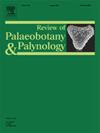气候因子对黑桤木(Alnus glutinosa)花粉粒发育的影响Gaertn)
IF 1.7
3区 地球科学
Q2 PALEONTOLOGY
引用次数: 0
摘要
花粉的可育性对植物的成功繁殖具有重要意义。它对环境条件,特别是气候因素很敏感。然而,关于气候因素对桤木属花粉发育的影响的研究却很少。Alnus glutinosa是一种地理分布广泛的欧亚树种。它在河岸生态系统中具有特别的生态重要性,在土壤稳定和生物多样性维持中起着至关重要的作用。本研究的目的是评价气候因子对11个不同种群花粉发育的影响,每个种群都有13个环境因子的独特组合。用三种不同的活力测试检测新鲜花粉样品:乙酰胭脂红染色、Lugol染色和体外萌发。结果表明,不同种群间花粉活力存在显著差异。乙酰胭脂红染色表明,桤木花粉具有较强的细胞质完整性,且没有明显的减数分裂异常。然而,Lugol染色显示花粉活力明显下降,这可能是由于温度升高导致新鲜花粉中淀粉含量下降。花粉发芽率普遍较低,且与海拔变化有关。因此,研究变暖对森林植物花粉活力和有性生殖的影响是当务之急,因为森林植物与其他植物一样容易受到气候变化的不利影响。本文章由计算机程序翻译,如有差异,请以英文原文为准。
Impact of climatic factors on pollen grains development in Black alder (Alnus glutinosa (L.) Gaertn)
Fertile pollen is of significance for the successful propagation of plants. It is sensitive to environmental conditions, especially climatic factors. However, there is a paucity of information about the effects of climatic factors on pollen development in the Alnus genus. Alnus glutinosa is an Eurasian species with a wide geographical distribution. It has particular ecological importance in riparian ecosystems, where it plays a crucial role in soil stabilization and biodiversity maintenance. The objective of the present study was to evaluate the effect of climatic factors on pollen development from eleven distinct populations, each characterized by a unique combination of 13 environmental factors. Fresh pollen samples were examined using three distinct viability tests: Acetocarmine staining, Lugol staining, and in vitro germination. The results revealed significant variations in pollen viability between populations. Acetocarmine staining revealed that pollen from Alnus glutinosa exhibited robust cytoplasmic integrity and an absence of significant meiotic anomalies. However, Lugol staining revealed a substantial decline in pollen viability, which can be attributed to a decrease in starch content in fresh pollen in response to elevated temperatures. Pollen germination rates were generally low and exhibited a dependence on altitude variations. Consequently, it is imperative to prioritize the investigation of the impact of warming on pollen viability and the sexual reproduction of forest plants, as they are susceptible to the adverse effects of climate change, akin to other plant species.
求助全文
通过发布文献求助,成功后即可免费获取论文全文。
去求助
来源期刊
CiteScore
3.50
自引率
21.10%
发文量
149
审稿时长
6 months
期刊介绍:
The Review of Palaeobotany and Palynology is an international journal for articles in all fields of palaeobotany and palynology dealing with all groups, ranging from marine palynomorphs to higher land plants. Original contributions and comprehensive review papers should appeal to an international audience. Typical topics include but are not restricted to systematics, evolution, palaeobiology, palaeoecology, biostratigraphy, biochronology, palaeoclimatology, paleogeography, taphonomy, palaeoenvironmental reconstructions, vegetation history, and practical applications of palaeobotany and palynology, e.g. in coal and petroleum geology and archaeology. The journal especially encourages the publication of articles in which palaeobotany and palynology are applied for solving fundamental geological and biological problems as well as innovative and interdisciplinary approaches.

 求助内容:
求助内容: 应助结果提醒方式:
应助结果提醒方式:


